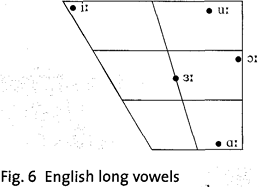


 Grammar
Grammar
 Tenses
Tenses
 Present
Present
 Past
Past
 Future
Future
 Parts Of Speech
Parts Of Speech
 Nouns
Nouns
 Verbs
Verbs
 Adverbs
Adverbs
 Adjectives
Adjectives
 Pronouns
Pronouns
 Pre Position
Pre Position
 Preposition by function
Preposition by function 
 Preposition by construction
Preposition by construction
 Conjunctions
Conjunctions
 Interjections
Interjections
 Grammar Rules
Grammar Rules
 Linguistics
Linguistics
 Semantics
Semantics
 Pragmatics
Pragmatics
 Reading Comprehension
Reading Comprehension
 Teaching Methods
Teaching Methods|
Read More
Date: 2024-11-08
Date: 2024-11-09
Date: 2024-10-11
|
The short vowels were introduced. We will look at other types of English vowel sound. The first to be introduced here are the five long vowels; these are the vowels which tend to be longer than the short vowels in similar contexts. It is necessary to say "in similar contexts" because, as we shall see later, the length of all English vowel sounds varies very much according to their context (such as the type of sound that follows them) and the presence or absence of stress. To remind you that these vowels tend to be long, the symbols consist of one vowel symbol plus a length mark made of two dots :. Thus we have i:, з:, a:, ɔ:, u:. We will now look at each of these long vowels individually.
The five long vowels are different from the six short vowels, not only in length but also in quality. If we compare some similar pairs of long and short vowels, for example I with i:, or ʊ with u:, or æ with ɑ:, we can see distinct differences in quality (resulting from differences in tongue shape and position, and lip position) as well as in length. For this reason, all the long vowels have symbols which are different from those of short vowels; you can see that the long and short vowel symbols would still all be different from each other even if we omitted the length mark, so it is important to remember that the length mark is used not because it is essential but because it helps learners to remember the length difference. Perhaps the only case where a long and a short vowel are closely similar in quality is that of ə and з:, but ə is a special case - as we shall see later.

i: (example words: 'beat', 'mean', 'peace') This vowel is nearer to cardinal vowel no. 1 [i] (i.e. it is closer and more front) than is the short vowel of 'bid', 'pin', 'fish'. Although the tongue shape is not much different from cardinal vowel no. 1, the lips are only slightly spread and this results in a rather different vowel quality.
з: (example words: 'bird', 'fern', 'purse') This is a mid-central vowel which is used in most English accents as a hesitation sound (written 'er'), but which many learners find difficult to copy. The lip position is neutral.
ɑ: (example words: 'card', 'half, 'pass') This is an open vowel in the region of cardinal vowel no. 6 [a], but not as back as this. The lip position is neutral.
ɔ: (example words: 'board', 'torn', 'horse') The tongue height for this vowel is between cardinal vowel no. 6 [ɔ] and no. 7 [o], and closer to the latter. This vowel is almost fully back and has quite strong lip-rounding.
u: (example words: 'food', 'soon', 'loose') The nearest cardinal vowel to this is no. 8 [u], but BBC u: is much less back and less close, while the lips are only moderately rounded.
|
|
|
|
دراسة: حفنة من الجوز يوميا تحميك من سرطان القولون
|
|
|
|
|
|
|
تنشيط أول مفاعل ملح منصهر يستعمل الثوريوم في العالم.. سباق "الأرنب والسلحفاة"
|
|
|
|
|
|
|
الطلبة المشاركون: مسابقة فنِّ الخطابة تمثل فرصة للتنافس الإبداعي وتنمية المهارات
|
|
|